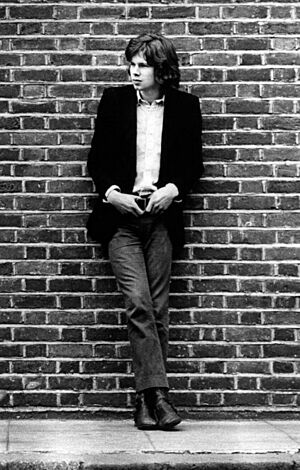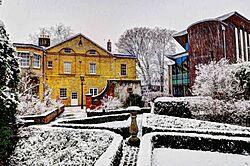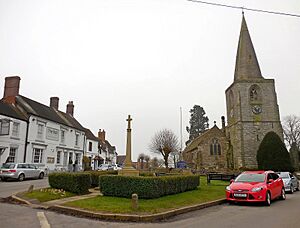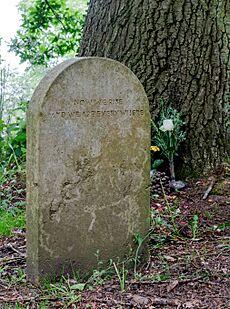Nick Drake facts for kids
Quick facts for kids
Nick Drake
|
|
|---|---|

Drake in 1969
|
|
| Background information | |
| Birth name | Nicholas Rodney Drake |
| Born | 19 June 1948 Rangoon, Burma |
| Died | 25 November 1974 (aged 26) Tanworth-in-Arden, England |
| Genres | |
| Instruments |
|
| Years active | 1967–1974 |
| Labels | Island |
Nicholas Rodney Drake (born June 19, 1948 – died November 25, 1974) was an English musician. He was a very skilled acoustic guitarist. Nick Drake signed with Island Records when he was twenty, while still studying at the University of Cambridge.
His first album, Five Leaves Left, came out in 1969. He then released two more albums: Bryter Layter (1971) and Pink Moon (1972). Nick Drake was not widely known during his short life. However, his music later received great praise and became much more recognized after he passed away.
Drake struggled with his feelings and did not like performing live. After finishing Pink Moon, he stopped performing and recording. He moved back to his parents' home in the countryside of Warwickshire. Nick Drake was found dead on November 25, 1974, at the age of 26.
His music stayed available through the 1970s. In 1979, a special album called Fruit Tree was released. This helped people rediscover his older songs. Many artists today say Nick Drake influenced their music. These include Robert Smith from the Cure, Peter Buck from R.E.M., Kate Bush, Paul Weller, Aimee Mann, Beck, and Robyn Hitchcock.
Contents
Early Life and Education (1948–1969)
Nicholas Rodney Drake was born in Burma on June 19, 1948. His father, Rodney Drake, worked as an engineer in Rangoon, Burma. In 1934, his father met Molly Lloyd, and they married in 1937. In 1951, the Drake family moved back to England. They lived in Warwickshire, in a home called Far Leys, in Tanworth-in-Arden.
Nick's older sister, Gabrielle Drake, became a successful actress. Both of Nick's parents also wrote music. Recordings of his mother Molly's songs show they had a similar style to Nick's later work. They both sang softly, and their music often had a thoughtful, serious mood. Nick's mother encouraged him to play piano when he was young. He started writing songs and recording them on a tape recorder at home.
In 1957, Nick went to Eagle House School, a boarding school. Five years later, he attended Marlborough College, a public school. His father and grandfather had also gone there. Nick became interested in sports. He was a good sprinter and played rugby. Friends remembered Nick as confident and often quiet. His father once said that people didn't know Nick very well.
Drake played piano, clarinet, and saxophone. He formed a band called the Perfumed Gardeners around 1964. Nick played piano, sometimes alto sax, and sang. The band played R&B and jazz songs.
Nick's focus on school lessened as he became more interested in music. In 1965, he bought his first acoustic guitar. It cost £13. He quickly learned special guitar techniques like open tuning and finger-picking.
In 1966, Drake earned a scholarship to Fitzwilliam College, Cambridge. He had ten months before starting there. So, he decided to spend six months at the University of Aix-Marseille in France. There, he practiced guitar a lot. He also played music with friends in the town to earn money.

Drake returned to England in 1967 and moved into his sister's flat in London. In October, he started studying English literature at Cambridge. His teachers thought he was smart but not very enthusiastic. One writer, Trevor Dann, noted that Nick had trouble connecting with teachers and other students. He preferred to stay in his room playing music instead of joining sports teams.
Music Career
In January 1968, Nick Drake met Robert Kirby. Robert was a music student who later wrote many string and woodwind parts for Nick's first two albums. By this time, Nick had discovered British and American folk music. He was influenced by artists like Bob Dylan, Donovan, and Van Morrison. He started playing in clubs and coffee houses in London. In December 1967, he played at an event in the Roundhouse. There, he impressed Ashley Hutchings, a bass player from Fairport Convention. Ashley thought Nick's guitar skills were great, and he looked like a star.
Ashley Hutchings introduced Nick to Joe Boyd. Joe was a 25-year-old American producer. He owned Witchseason Productions, which worked with Island Records. Boyd was well-known in the UK folk music scene. He and Nick quickly connected, and Boyd became a mentor to Nick. Boyd was impressed by a demo Nick recorded in his college room. He offered Nick a contract. Boyd remembered listening to Nick's recording and thinking it was "pretty special." Nick was excited about the contract and decided not to finish his third year at Cambridge.
First Album: Five Leaves Left (1969)
Nick Drake recorded his first album, Five Leaves Left, in 1968. Joe Boyd was the producer. Nick had to miss classes to travel to the studio in London. Boyd wanted to record Nick's voice in a close, personal way. He also wanted to add string music without making it sound too "pop." Boyd brought in musicians from the London folk rock scene. These included Richard Thompson and Danny Thompson.
The first recording sessions were difficult and rushed. There were disagreements about how the album should sound. Boyd liked using the studio to create sounds, but Nick preferred a more natural sound. Nick suggested his college friend Robert Kirby as an arranger. Boyd was unsure about using an inexperienced student, but Nick was unusually firm. So, Boyd agreed to try. Kirby wrote most of the arrangements for the album.
The album's release was delayed for several months. It was not well-marketed. In July, Melody Maker called it "poetic" and "interesting." But NME said it didn't have enough variety. It was rarely played on the radio, except on shows by DJs like John Peel. Nick was unhappy with the album's cover. It listed songs in the wrong order and included lyrics that weren't in the recorded versions. His sister Gabrielle said he was very private about his music.
Second Album: Bryter Layter (1971)
Nick Drake left Cambridge before graduating in late 1969 and moved to London. His father wrote him letters, saying a degree was a "safety net." But Nick replied that he didn't want a safety net. Nick spent his first few months in London moving around. He often stayed at friends' places. Joe Boyd eventually helped him get a flat in London.
On August 5, 1969, Nick recorded four songs for a BBC radio show. A month later, he opened for Fairport Convention at the Royal Festival Hall. He also played at folk clubs. According to folk singer Michael Chapman, audiences didn't understand Nick's music. They wanted songs with choruses. Chapman said Nick didn't speak the whole evening. It was hard to watch.
This experience made Nick want to stop playing live shows. The few concerts he did play were short and awkward. Nick seemed unwilling to perform and rarely spoke to the audience. He often paused to retune his guitar.
Even though Five Leaves Left didn't get much attention, Boyd wanted to keep the momentum going. Nick's second album, Bryter Layter (1971), was also produced by Boyd. It had a more upbeat, jazzier sound. Nick was disappointed with his first album's sales. He agreed to Boyd's idea to add bass and drum tracks. Boyd thought it would be more commercial. The album featured musicians from Fairport Convention. John Cale also played on two songs, including "Northern Sky."
Bryter Layter did not sell well, and reviews were mixed. Record Mirror praised Nick as a "beautiful guitarist." But Melody Maker called the album "an awkward mix of folk and cocktail jazz." After the album came out, Boyd sold his company to Island Records and moved to Los Angeles. Losing his mentor and the album's poor sales made Nick feel worse. He became unhappy living alone in London. In June, Nick played one of his last live shows. Another musician, Ralph McTell, remembered Nick being very shy. Nick walked off stage halfway through a song.
Island Records wanted Nick to promote Bryter Layter with interviews and live shows. But Nick refused. He was disappointed and started to withdraw from his family and friends.
Third Album: Pink Moon (1972)
Even though Island Records didn't expect a third album, Nick contacted John Wood in October 1971. He wanted to start working on his final album. The recording sessions happened over two nights. Only Nick and Wood were in the studio. The songs on Pink Moon are short. The album has eleven tracks and lasts only 28 minutes. Wood said this length was "just about right." Nick had not liked the sound of Bryter Layter. He felt the added instruments made it "too full." On Pink Moon, Nick is only joined by his own guitar. There is a piano part on the title track. Wood said that Pink Moon was probably more like Nick himself than the other two albums.
Nick delivered the tapes of Pink Moon to Chris Blackwell at Island Records. An advertisement for the album in Melody Maker said, "Pink Moon—Nick Drake's latest album: the first we heard of it was when it was finished." Pink Moon sold fewer copies than his previous albums. However, it did get some good reviews. Connor McKnight wrote in Zigzag that Nick Drake was an artist who was always true to himself.
Blackwell thought Pink Moon could make Nick famous. But his staff were disappointed that Nick would not promote it. Nick agreed to one interview with Jerry Gilbert of Sounds Magazine. Nick was very shy and quiet. He spoke about not liking live shows and little else. Gilbert said Nick didn't even make eye contact with him. Feeling discouraged, Nick stopped making music. He thought about other jobs, even joining the army. His three albums together had sold fewer than 4,000 copies.
Later Recordings (1973–1974)
In February 1973, Nick Drake contacted John Wood. He said he was ready to start a fourth album. Joe Boyd was in England and agreed to be at the recordings. More recordings happened in July 1974. Boyd noticed that Nick's performance had changed. Nick had to record his voice separately from his guitar. However, being back in the studio made Nick feel better. His mother remembered being thrilled that Nick was happy again.
Personal Life
In 1971, Nick's family encouraged him to see a doctor in London. He was given medicine to help him feel better. But he felt uncomfortable taking it and tried to hide it from friends.
After Pink Moon was released, Nick became more private. He moved back to his parents' home in Tanworth-in-Arden. He didn't like living at home, but he felt he couldn't be anywhere else. His return was sometimes hard for his family. His sister Gabrielle said their lives revolved around how Nick was feeling.
Nick lived a simple life. His only money was a small payment each week from Island Records. At one point, he couldn't even afford new shoes. He would sometimes disappear for days. He would show up at friends' houses, quiet and withdrawn. Robert Kirby described a visit: "He would arrive and not talk, sit down, listen to music, have a smoke, have a drink, sleep there the night, and two or three days later he wasn't there, he'd be gone."
John Martyn (who wrote a song about Nick in 1973) said Nick was the most private person he had ever met. Nick would borrow his mother's car and drive for hours without a plan. He would drive until he ran out of gas and had to call his parents for a ride. Friends noticed how much his appearance had changed. During very difficult times, he didn't wash his hair or cut his nails. In early 1972, Nick was very unwell and stayed in the hospital for five weeks.
By late 1974, Nick's weekly payment from Island had stopped. He only kept in touch with a few close friends. He tried to stay in contact with Sophia Ryde, a close friend he met in London in 1968.
Death
In the early morning of November 25, 1974, Nick Drake died in his bedroom at Far Leys. He had gone to bed early after visiting a friend. His mother said he went to the kitchen around dawn, which he often did. He returned to his room shortly after. The exact cause of his death is not known, as no detailed examination was done.
On December 2, 1974, after a service, Nick Drake's remains were cremated. His ashes were buried under an oak tree in the churchyard of the Church of St Mary Magdalene, Tanworth-in-Arden. About fifty people attended the funeral, including friends from different parts of his life. His mother remembered meeting many of his young friends for the first time that day.
Musical Style
Nick Drake practiced his guitar playing a lot. He would stay up late writing and trying out different ways to tune his guitar. His mother remembered hearing him "bumping around at all hours." She thought he wrote his best melodies in the early morning. He taught himself to play guitar. He used special tunings to create unique sounds that are hard to make with regular guitar tuning. He sang in a lower voice, often quietly.
Drake was inspired by writers like William Blake and William Butler Yeats. Their ideas are seen in his song lyrics. He also used many symbols from nature, like the moon, stars, sea, rain, trees, and seasons. These were influenced by growing up in the countryside. Images of summer are common in his early songs. Later, his songs used more autumn images, which often suggest feelings of loss or sadness. Nick often wrote as an observer, as if he was watching his own life from a distance.
Legacy and Popularity
After Nick Drake's death, there were no documentaries or special albums for a while. His music was not widely known through the 1970s. However, his parents started to receive more fans visiting their home. In 1979, Island Records released a box set called Fruit Tree. It included his three albums and some other songs. This helped people discover his music.
By the mid-1980s, musicians like Kate Bush, Paul Weller, and Peter Buck from R.E.M. said Nick Drake influenced them. In 1985, the band The Dream Academy dedicated their hit song "Life in a Northern Town" to Drake. By the end of the 1980s, his name appeared more often in UK music magazines. He was often seen as a "doomed romantic hero."
The first book about Nick Drake in English came out in 1997. In 1998, BBC Radio 2 aired a documentary about him. The next year, BBC Two showed a 40-minute documentary. In 2000, a Dutch director released a documentary called A Skin Too Few: The Days of Nick Drake. Later that year, The Guardian newspaper called Bryter Layter the best alternative album ever.
In 1999, Nick's song "Pink Moon" was used in a Volkswagen car commercial. This greatly increased his album sales in the US. Fans also used file-sharing programs like Napster to share his music. The Atlantic magazine noted that Nick's shyness, which made it hard for him to compete with big stars in the 1970s, didn't matter when his songs were found online.
In the following years, Nick Drake's songs appeared in movies like The Royal Tenenbaums and Garden State. A special album of his unreleased songs, Made to Love Magic, came out in 2004. It sold far more copies than any of his albums did during his lifetime. Other artists like José González and Bon Iver have also been influenced by Nick Drake. In 2023, a tribute album called The Endless Coloured Ways: The Songs of Nick Drake was released.
In 1994, a journalist from Rolling Stone said Nick Drake's music had a "beautiful" feeling. Music critic Richie Unterberger called Drake a "singular talent" who made "chilling, somber beauty" albums. He said Nick's music is now seen as a top achievement in British folk-rock. Unterberger felt that Drake's music appeals to people of all ages.
In July 2024, a special concert called "Nick Drake: an Orchestral Celebration" will happen at the Royal Albert Hall. The BBC Symphony Orchestra will perform some of his songs. This concert will celebrate 50 years since Nick Drake's death.
Discography
- Five Leaves Left (1969)
- Bryter Layter (1971)
- Pink Moon (1972)
See also
 In Spanish: Nick Drake para niños
In Spanish: Nick Drake para niños



